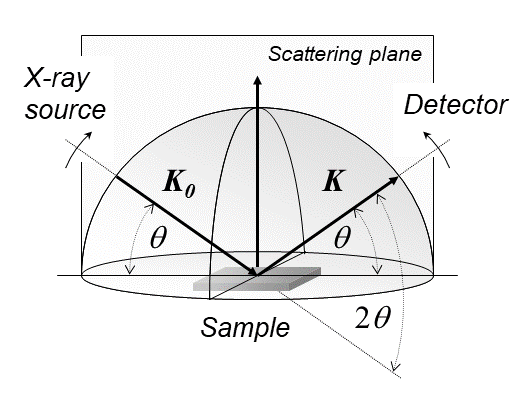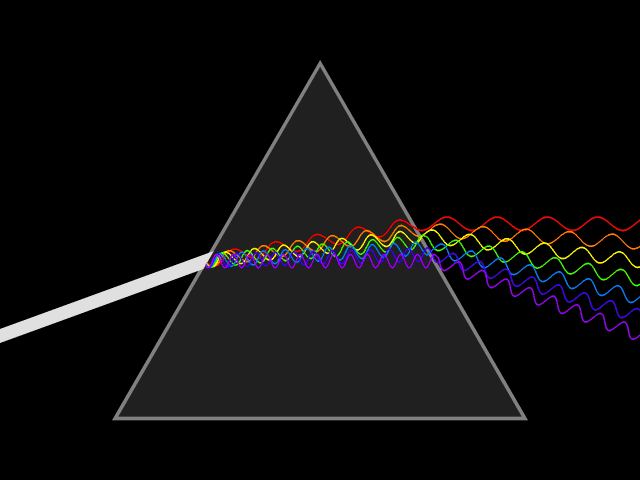|
Anomalous Scattering
Anomalous X-ray scattering (AXRS or XRAS) is a non-destructive determination technique within X-ray diffraction that makes use of the anomalous dispersion that occurs when a wavelength is selected that is in the vicinity of an absorption edge of one of the constituent elements of the sample. It is used in materials research to study nanometer sized differences in structure. Atomic scattering factors In X-ray diffraction the scattering factor ''f'' for an atom is roughly proportional to the number of electrons that it possesses. However, for wavelengths that approximate those for which the atom strongly absorbs radiation the scattering factor undergoes a change due to anomalous dispersion. The dispersion not only affects the magnitude of the factor but also imparts a phase shift in the elastic collision of the photon. The scattering factor can therefore best be described as a complex number: : ''f'' = ''f''o + Δ''f + ''i''Δ''f"'' Contrast variation The anomalous aspects of X-ray ... [...More Info...] [...Related Items...] OR: [Wikipedia] [Google] [Baidu] |
X-ray Diffraction
X-ray diffraction is a generic term for phenomena associated with changes in the direction of X-ray beams due to interactions with the electrons around atoms. It occurs due to elastic scattering, when there is no change in the energy of the waves. The resulting map of the directions of the X-rays far from the sample is called a diffraction pattern. It is different from X-ray crystallography which exploits X-ray diffraction to determine the arrangement of atoms in materials, and also has other components such as ways to map from experimental diffraction measurements to the positions of atoms. This article provides an overview of X-ray diffraction, starting with the early #History, history of x-rays and the discovery that they have the right spacings to be diffracted by crystals. In many cases these diffraction patterns can be #Introduction to x-ray diffraction theory, Interpreted using a single scattering or kinematical theory with conservation of energy (#Ewald's sphere, wave vecto ... [...More Info...] [...Related Items...] OR: [Wikipedia] [Google] [Baidu] |
Anomalous Dispersion
Dispersion is the phenomenon in which the phase velocity of a wave depends on its frequency. Sometimes the term chromatic dispersion is used to refer to optics specifically, as opposed to wave propagation in general. A medium having this common property may be termed a dispersive medium. Although the term is used in the field of optics to describe light and other electromagnetic waves, dispersion in the same sense can apply to any sort of wave motion such as acoustic dispersion in the case of sound and seismic waves, and in gravity waves (ocean waves). Within optics, dispersion is a property of telecommunication signals along transmission lines (such as microwaves in coaxial cable) or the pulses of light in optical fiber. In optics, one important and familiar consequence of dispersion is the change in the angle of refraction of different colors of light, as seen in the spectrum produced by a dispersive prism and in chromatic aberration of lenses. Design of compound achromatic ... [...More Info...] [...Related Items...] OR: [Wikipedia] [Google] [Baidu] |
Complex Number
In mathematics, a complex number is an element of a number system that extends the real numbers with a specific element denoted , called the imaginary unit and satisfying the equation i^= -1; every complex number can be expressed in the form a + bi, where and are real numbers. Because no real number satisfies the above equation, was called an imaginary number by René Descartes. For the complex number is called the , and is called the . The set of complex numbers is denoted by either of the symbols \mathbb C or . Despite the historical nomenclature, "imaginary" complex numbers have a mathematical existence as firm as that of the real numbers, and they are fundamental tools in the scientific description of the natural world. Complex numbers allow solutions to all polynomial equations, even those that have no solutions in real numbers. More precisely, the fundamental theorem of algebra asserts that every non-constant polynomial equation with real or complex coefficie ... [...More Info...] [...Related Items...] OR: [Wikipedia] [Google] [Baidu] |
Synchrotron Radiation
Synchrotron radiation (also known as magnetobremsstrahlung) is the electromagnetic radiation emitted when relativistic charged particles are subject to an acceleration perpendicular to their velocity (). It is produced artificially in some types of particle accelerators or naturally by fast electrons moving through magnetic fields. The radiation produced in this way has a characteristic polarization, and the frequencies generated can range over a large portion of the electromagnetic spectrum. Synchrotron radiation is similar to bremsstrahlung radiation, which is emitted by a charged particle when the acceleration is parallel to the direction of motion. The general term for radiation emitted by particles in a magnetic field is ''gyromagnetic radiation'', for which synchrotron radiation is the ultra-relativistic special case. Radiation emitted by charged particles moving non-relativistically in a magnetic field is called cyclotron emission. For particles in the mildly relativ ... [...More Info...] [...Related Items...] OR: [Wikipedia] [Google] [Baidu] |
Resonant Anomalous X-ray Scattering
X-ray scattering techniques are a family of analytical techniques which reveal information about the crystal structure, chemical composition, and physical properties of materials and thin films. These techniques are based on observing the scattered intensity of an X-ray beam hitting a sample as a function of incident and scattered angle, polarization, and wavelength or energy. Note that X-ray diffraction is sometimes considered a sub-set of X-ray scattering, where the scattering is elastic and the scattering object is crystalline, so that the resulting pattern contains sharp spots analyzed by X-ray crystallography (as in the Figure). However, both scattering and diffraction are related general phenomena and the distinction has not always existed. Thus Guinier's classic text from 1963 is titled "X-ray diffraction in Crystals, Imperfect Crystals and Amorphous Bodies" so 'diffraction' was clearly not restricted to crystals at that time. Scattering techniques Elastic scattering * ... [...More Info...] [...Related Items...] OR: [Wikipedia] [Google] [Baidu] |
Multi-wavelength Anomalous Diffraction
Multi-wavelength anomalous diffraction (sometimes Multi-wavelength anomalous dispersion; abbreviated MAD) is a technique used in X-ray crystallography that facilitates the determination of the three-dimensional structure of biological macromolecules (e.g. DNA, drug receptors) via solution of the phase problem. MAD was developed by Wayne Hendrickson while working as a postdoctoral researcher under Jerome Karle at the United States Naval Research Laboratory. The mathematics upon which MAD (and progenitor Single-wavelength anomalous diffraction) was based were developed by Jerome Karle, work for which he was awarded the 1985 Nobel Prize in Chemistry (along with Herbert Hauptman). Compared to the predecessor SAD, MAD has greatly elevated phasing power from using multiple wavelengths close to the edge. However, because it requires a synchrotron beamline, a longer exposure (risking radiation damage), and only allows a limited choice of heavy atoms (those with edges reachable by a synchr ... [...More Info...] [...Related Items...] OR: [Wikipedia] [Google] [Baidu] |
Single-wavelength Anomalous Diffraction
Single-wavelength anomalous diffraction (SAD) is a technique used in X-ray crystallography that facilitates the determination of the structure of proteins or other biological macromolecules by allowing the solution of the phase problem. In contrast to multi-wavelength anomalous diffraction (MAD), SAD uses a single dataset at a single appropriate wavelength. Compared to MAD, SAD has weaker phasing power and requires density modification to resolve phase ambiguity. This downside is not as important as SAD's main advantage: the minimization of time spent in the beam by the crystal, thus reducing potential radiation damage to the molecule while collecting data. SAD also allows a wider choice of heavy atoms and can be conducted without a synchrotron beamline. Today, selenium-SAD is commonly used for experimental phasing due to the development of methods for selenomethionine incorporation into recombinant proteins. SAD is sometimes called "single-wavelength anomalous dispersion", but no ... [...More Info...] [...Related Items...] OR: [Wikipedia] [Google] [Baidu] |
Diffraction Anomalous Fine Structure
Diffraction is the deviation of waves from straight-line propagation without any change in their energy due to an obstacle or through an aperture. The diffracting object or aperture effectively becomes a secondary source of the propagating wave. Diffraction is the same physical effect as interference, but interference is typically applied to superposition of a few waves and the term diffraction is used when many waves are superposed. Italian scientist Francesco Maria Grimaldi coined the word ''diffraction'' and was the first to record accurate observations of the phenomenon in 1660. In classical physics, the diffraction phenomenon is described by the Huygens–Fresnel principle that treats each point in a propagating wavefront as a collection of individual spherical wavelets. The characteristic pattern is most pronounced when a wave from a coherent source (such as a laser) encounters a slit/aperture that is comparable in size to its wavelength, as shown in the inserted image. ... [...More Info...] [...Related Items...] OR: [Wikipedia] [Google] [Baidu] |
X-ray Absorption Fine Structure
X-ray absorption fine structure (XAFS) is a specific structure observed in X-ray absorption spectroscopy (XAS). By analyzing the XAFS, information can be acquired on the local structure and on the unoccupied local electronic states. Atomic spectra The atomic X-ray absorption spectrum (XAS) of a core-level in an absorbing atom is separated into states in the discrete part of the spectrum called "bounds final states" or " Rydberg states" below the ionization potential (IP) and "states in the continuum" part of the spectrum above the ionization potential due to excitations of the photoelectron in the vacuum. Above the IP the absorption cross section attenuates gradually with the X-ray energy. Following early experimental and theoretical works in the thirties, in the sixties using synchrotron radiation at the National Bureau of Standards it was established that the broad asymmetric absorption peaks are due to Fano resonances above the atomic ionization potential where the final st ... [...More Info...] [...Related Items...] OR: [Wikipedia] [Google] [Baidu] |
Scientific Techniques
A scientific technique is any systematic way of obtaining information about a scientific nature or to obtain a desired material or product. Scientific techniques can be divided in many different groups, e.g.: # Preparative techniques ## Synthesis techniques, e.g. the use of Grignard reagents in organic chemistry Organic chemistry is a subdiscipline within chemistry involving the science, scientific study of the structure, properties, and reactions of organic compounds and organic matter, organic materials, i.e., matter in its various forms that contain ... ## Growth techniques, e.g. crystal growth or cell cultures in biology ## Purification techniques e.g. List of purification methods in chemistry, those in chemistry # Measurement techniques ## Analysis techniques, e.g. ones that reveal atomic or molecular composition. ## Characterization techniques, e.g. ones that measure a certain property of a material. ## Imaging techniques, e.g. microscopy In some cases these methods h ... [...More Info...] [...Related Items...] OR: [Wikipedia] [Google] [Baidu] |



